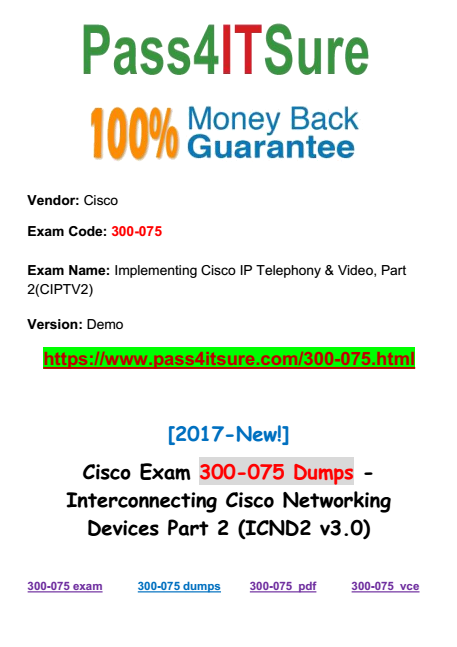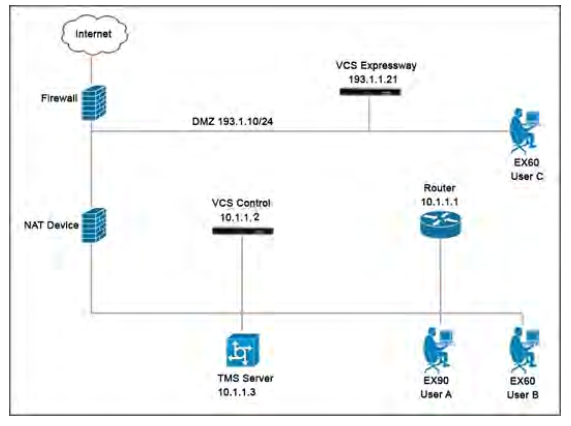Are you qualified enough to pass the Cisco 300-075 dump exam? “Implementing Cisco IP Telephony & Video, Part 2 v1.0” also known as 300-075 exam, is a Cisco certification which covers all the knowledge points of the real Cisco exam. Most popular Cisco CCNP Collaboration 300-075 dump CIPTV2 pdf 100% pass with a high score Youtube training. Pass4itsure Cisco 300-075 dumps exam questions answers are updated (383 Q&As) are verified by experts.
The associated certifications of 300-075 dumps is CCNP Collaboration. Our experts have made two types of learning material according to the need of https://www.pass4itsure.com/300-075.html dump Implementing Cisco IP Telephony and Video, Part 2 (CIPTV2) exam applicants.
Exam Code: 300-075
Exam Name: Implementing Cisco IP Telephony & Video, Part 2 v1.0
Q&As: 383
[Cisco Data Center 300-075 Dump From Google Drive]: https://drive.google.com/open?id=0BwxjZr-ZDwwWTk00ekx3V0xfX3c
[Cisco Data Center 200-355 Dumps From Google Drive]: https://drive.google.com/open?id=0BwxjZr-ZDwwWUkUwT0lYclNxbFU

Pass4itsure Cisco 300-075 Dump Exam Questions – 100% Success Guaranteed:
Question No : 13
Which three commands are mandatory to implement SRST for five Cisco IP Phones? (Choose three.)
A. call-manager-fallback
B. max-ephones
C. keepalive
D. limit-dn
E. ip source-address
300-075 exam Answer: A,B,E
Question No : 14 You want to perform Media Gateway Control Protocol gateway maintenance. For this purpose, you disable Media Control Gateway Protocol gateway using the no mgcp command. After you perform the maintenance, you want to enable the Media Control Gateway Protocol gateway. Which command should you use?
A. enable mgcp
B. mgcp
C. mgcp enable
D. mgcp yes
E. activate mgcp
F. mgcp active
Answer: B
Question No : 15 Which two options should be selected in the SIP trunk security profile that affect the SIP trunk pointing to the VCS? (Choose two.)
A. Accept Unsolicited Notification
B. Enable Application Level Authorization
C. Accept Out-of-Dialog REFER
D. Accept Replaces Header
E. Accept Presence Subscription
300-075 dump Answer: A,D
Question No : 16 When considering Cisco Unified Communications Manager failover, how many backup servers can be configured in a Cisco Unified Communications Manager Group?
A. 1
B. 5
C. 2
D. 4
E. 3
F. 6
Answer: C
Question No : 17 A voicemail product that supports only the G.711 codec is installed in headquarters. Which action allows branch Cisco IP phones to function with voicemail while using only the G.729 codec over the WAN link to headquarters?
A. Configure Cisco Unified Communications Manager regions.
B. Configure transcoding within Cisco Unified Communications Manager.
C. Configure transcoding resources in Cisco IOS and assign to the MRGL of Cisco IP phones.
D. Configure transcoder resources in the branch Cisco IP phones.
300-075 pdf Answer: C
Question No : 18 The Cisco Unified Communications system of a company has five types of devices:
•Cisco Jabber Desktop
•CP-7965
•DX-650
•EX-60
•MX-200
Which two types of devices are affected when an engineer changes the DSCP for Video Calls service parameter? (Choose two.)
A.DX-650
B.Cisco Jabber Desktop
C.CP-7965
D.EX-60
E.MX-200
Answer: A,C
Question No : 19 When configuring Cisco Unified Survivable Remote Site Telephony, which CLI command enables this feature on the router?
A. call-manager-fallback
B. ccm-manager redundant-host
C. ccm-manager sccp local
D. ccm-manager switchback
300-075 vce Answer: A
Question No : 20
Refer to the exhibit.

Which three statements about when user A calls user using SIP are true? (Choose three.)
A. SIP TCP/TLS ports must be opened from internal to DMZ and vice versa.
B. Deploying a Cisco VCS Expressway behind a NAT mandates the use of the Advanced Networking option key.
C. Cisco VCS Control and Cisco VCS Expressway support static NAT.
D. Deploying a Cisco VCS Control inside a NAT mandates the use of the Advanced Networking option key.
E. RT and RTCP ports must be opened at the firewall from internal to DMZ and vice versa
F. The NAT device must translate from 10.X.X X to 193.1.1.X and vice versa.
Answer: A,B,E
QUESTION NO: 21
What happens when you attempt to compile and run the following code?
#include <iostream>
using namespace std;
int main()
{
int x=2, *y, z=3;
y = &z;
cout<<x**y*x***y;
return 0;
}
A. It prints: 36
B. It prints: 14
C. It prints: 16
D. Compilation error
300-075 exam Answer: D
QUESTION NO: 22
What happens when you attempt to compile and run the following code?
#include <iostream>
using namespace std;
#define DEF_A 0
int main(int argc, char *argv[]) {
cout << DEF_A;
return 0;
}
A. It prints: 1
B. It prints: 0
C. It prints: ?1
D. Compilation error
Answer: B
QUESTION NO: 23
What happens when you attempt to compile and run the following code?
#include <iostream>
#include <exception>
using namespace std;
class myClass : public exception
{
virtual const char* what() const throw()
{
return “My exception.”;
}
} obj;
int main () {
try
{
throw obj;
}
catch (exception& e)
{
cout << e.what() << endl;
}
return 0;
}
A. It prints: My exception.
B. It prints: 0
C. It prints: 1
D. Compilation error
300-075 dump Answer: A
QUESTION NO: 24
What happens when you attempt to compile and run the following code?
#include <iostream>
using namespace std;
class A
{
public:
void Print(){ cout<<“A”;}
};
class B:public A
{
public:
virtual void Print(){ cout<< “B”;}
};
int main()
{
A *obj;
A ob1;
obj = &ob1;
obj?>Print();
B ob2;
obj = &ob2;
obj?>Print();
}
A. It prints: AB
B. It prints: AA
C. It prints: BA
D. It prints: BB
Answer: B
QUESTION NO: 25
What happens when you attempt to compile and run the following code?
#include <iostream>
using namespace std;
int main()
{
const int x=0;
const int *ptr;
ptr = &x;
cout<<*ptr;
return 0;
}
A. It prints: 0
B. It prints address of x
C. It prints: 1
D. Compilation error
300-075 pdf Answer: A
QUESTION NO: 26
What happens when you attempt to compile and run the following code?
#include <iostream>
using namespace std;
int main(){
int i = 1;
for(i=10; i>-1; i/=2) {
if(!i)
break;
}
cout << i;
return 0;
}
A. It prints: 0
B. It prints: 1
C. It prints: -1
D. Compilation error
Answer: A
QUESTION NO: 27
What happens when you attempt to compile and run the following code?
#include <iostream>
#include <string>
using namespace std;
B() { x=1;}
};
class C :public A, public B {
public:
int x;
C(int x) {
this?>x = x;
A.x = x + 1;
}
void Print() { cout << x << A::x << B::x; }
};
int main () {
C c2(1);
c2.Print();
return 0;
}
B. It prints: 1
C. It prints: 121
D. It prints: 111
E. It prints: 2
300-075 vce Answer: B
QUESTION NO: 28
What happens when you attempt to compile and run the following code?
#include <iostream>
using namespace std;
namespace myNamespace1
{
int x = 5;
int y = 10;
}
namespace myNamespace2
{
float x = 3.14;
float y = 1.5;
}
int main () {
{
using namespace myNamespace1;
cout << x << ” “;
}{
using namespace myNamespace2;
cout << y;
}
return 0;
}
A. It prints: 5 1.5
B. It prints: 3.14 10
C. Compilation error
D. None of these
Answer: A
QUESTION NO: 29
What happens when you attempt to compile and run the following code?
#include <iostream>
using namespace std;
int main() {
float i = 1.0 / 2 * 2 / 1 * 2 / 4 * 4 / 2;
cout << i;
return 0;
}
A. It prints: 0
B. It prints: 1
C. It prints: 2
D. It prints: 0.5
300-075 exam Answer: B
We are providing PDF format solved questions and answers and practice test software 300-075 dump Implementing Cisco IP Telephony and Video, Part 2 (CIPTV2) exam. Pass4itsure gives 100% surety that you will pass in https://www.pass4itsure.com/300-075.html dump exam in first attempt if you buy and use our product. We are giving you the amazing discount offer on the purchase of bundle.